Sandakan Death Marches
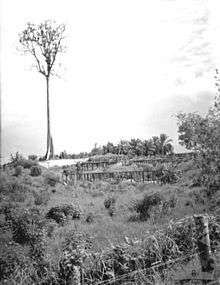
The Sandakan Death Marches were a series of forced marches in Borneo from Sandakan to Ranau which resulted in the deaths of 2,345 Allied prisoners of war held captive by the Empire of Japan during the Pacific campaign of World War II in the Sandakan POW Camp. By the end of the war, of all the prisoners who had been incarcerated at Sandakan and Ranau, only six Australians survived, all of whom had escaped. It is widely considered to be the single worst atrocity suffered by Australian servicemen during the Second World War.[1]
Background
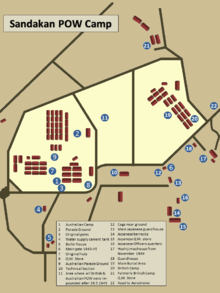
In 1942 and 1943, Australian and British POWs who had been captured at the Battle of Singapore in February 1942 were shipped to North Borneo to construct a military airstrip and prisoner-of-war camps at Sandakan, North Borneo (Sabah). As on the Burma Railway the prisoners were forced to work at gunpoint, and were often beaten whilst also receiving very little food or medical attention. In August 1943, with the intention of controlling the enlisted men by removing any commanders, most officer prisoners were moved from Sandakan to the Batu Lintang camp at Kuching. Conditions for the remaining prisoners deteriorated sharply following the officers' removal. Any rations given were further reduced, and sick prisoners were also forced to work on the airstrip. After construction was completed the prisoners initially remained at the camp. In January 1945, with only 1,900 prisoners still alive, the advancing Allies managed to successfully bomb and destroy the airfield. It was at this time with Allied landings anticipated shortly that camp commandant Captain Hoshijima Susumu decided to move the remaining prisoners westward into the mountains to the town of Ranau, a distance of approximately 260 kilometres (160 mi). He claimed that this was an order of Lt Gen Baba Masao, commanding officer of the 37th Japanese Army.
The former military airstrip is now known as Sandakan Airport, which serves Sandakan town.
Events
The first marches
The first phase of marches across wide marshland, dense jungle, and then up the eastern slope of Mount Kinabalu occurred between January and March 1945. The Japanese had selected 470 prisoners who were thought to be fit enough to carry baggage and supplies for the accompanying Japanese battalions relocating to the western coast. In several groups the POWs, all of whom were either malnourished or suffering serious illness, started the journey originally under the intention of reaching Jesselton (Kota Kinabalu). Although the route took nine days, they were given enough rations for only four days. As on the Bataan Death March, any POWs who were not fit enough or collapsed from exhaustion were either killed or left to die en route. Upon reaching Ranau, the survivors were halted and ordered to construct a temporary camp. As one historian later commented: "Those who survived... were herded into insanitary and crowded huts to then die from dysentery. By 26 June, only five Australians and one British soldier were still alive."[2]
The second marches
A second series of marches began on 29 May 1945 with approximately 536 prisoners.[3] The new Sandakan camp commander, Captain Takakuwa Takuo, ordered the prisoners towards Ranau in groups of about fifty with accompanying Japanese guards. The march lasted for twenty-six days, with prisoners even less fit than those in the first marches had been, provided with fewer rations and often forced to forage for food. Compound No. 1 of the Sandakan camp was destroyed in an attempt to erase any evidence of its existence.[4] Only 183 prisoners managed to reach Ranau. Upon their arrival on 24 June 1945, participants of the second marches discovered that only six prisoners from the first series of marches during January were still alive.
The final march
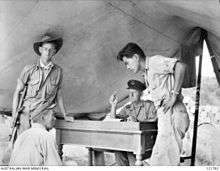
Approximately 250 people were left at Sandakan after the second march departed. Most prisoners were so ill that the Japanese initially intended to let them starve to death forcing many to scavenge in the surrounding forest for food. However, on 9 June 1945 it was decided to send another group of 75 men on a final march. The remaining men were so weak that none survived beyond 50 kilometres (31 mi). As each man collapsed from exhaustion, that man was shot by a Japanese guard. All remaining prisoners left at Sandakan who could not walk either were killed or died from a combination of starvation and sickness before the Japanese surrender on 15 August 1945. However it was not just the POW who suffered, with many Japanese soldiers also dying of starvation with some even turning to cannibalism in order to preserve their fighting effectiveness.[5]
Aftermath
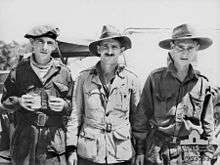
Due to a combination of a lack of food and brutal treatment at the hands of the Japanese, there were only 38 prisoners left alive at Ranau by the end of July. All were too unwell and weak to do any work, and it was ordered that any remaining survivors should be shot. They were killed by the guards during August, possibly up to 12 days after the end of the war on 14 August.[6] Furthermore, it has been estimated that 16% of the population of Sabah were killed during the three years of Japanese occupation, a reflection of the sheer brutality.[7]
In total, only six Australian servicemen managed to escape. During the second marches, Gunner Owen Campbell and Bombardier Richard Braithwaite managed to escape into the jungle, where they were assisted by locals and eventually rescued by Allied units. During July, Private Nelson Short, Warrant Officer William Sticpewich, Private Keith Botterill and Lance Bombardier William Moxham managed to escape from Ranau and were also helped by the local people, who fed them and hid them from the Japanese until the end of the war. Of the six survivors, only four (Sticpewich, Botterill, Short, & Campbell) survived the lingering effects of their ordeal to give evidence at various war crimes trials in both Tokyo and Rabaul. The world was able to receive eyewitness accounts of the crimes and atrocities committed. Captain Hoshijima was found guilty of war crimes and hanged on 6 April 1946.[8] Capt Takakuwa and his second-in-charge, Capt Watanabe Genzo, were found guilty of causing the murders and massacres of prisoners-of-war and were hanged and shot on 6 April 1946 and 16 March 1946 respectively.
Commemorations

A War Memorial and Gardens of remembrance were built at Kundasang, Sabah in 1962 to commemorate those who had died at Sandakan and Ranau.[9][10]
The Sandakan Death Marches have been dramatised in the 2004 oratorio Sandakan Threnody — a threnody being a hymn of mourning, composed as a memorial to a dead person. The oratorio was written by Australian composer Jonathan Mills, whose father survived a term of imprisonment at Sandakan in 1942–43.
In 2011, Year 9 and 10 Drama Students at Toodyay District High School, in Western Australia, re-dramatised an updated version of the original 1947 ABC Radio play 'Six From Borneo' with help from the Toodyay community, including Toodyay Community Radio, the Shire of Toodyay and Toodyay RSL. The launch of the Six From Borneo Project was attended by the Malaysian Consul General Puan Hamidah Ashari, Member for Moore Grant Woodhams MLA, Military Historian Lynette Silver, relatives of Sandakan POWs and Toodyay community members. On 9 September 2011, audio excerpts of the original recording were played on ABC radio (WA Perth 720) for the first time since 1947, along with audio excerpts of the rerecording. The play was due to be broadcast on Toodyay Community Radio in late 2011 and was then to be offered to other community radio stations across Australia. A copy of the rerecording has been submitted to the National Film and Sound Archive of Australia and to the ABC library in Perth, Western Australia.
Sandakan was referred to by Prime Minister Shinzo Abe in his speech to the Australian parliament on 8 July 2014. It was the first speech to the parliament by a Japanese leader.[11][12][13][14]
POW route
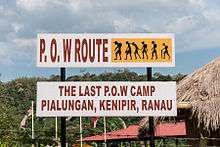
The "POW Route" during the three death marches series was documented in 1945 by British and Australian military. The route begins in Sandakan and ends at the "Last Camp" at Ranau. The stations of the route are now marked with a sign board.
See also
- Bataan Death March
- Batu Lintang camp
- Berhala Island, Sandakan
- Borneo campaign, 1945
- Tatsuji Suga
- Frederick Campling
Footnotes
- ↑ Digger History Sandakan Death March: Japanese Inhumanity
- ↑ The Marches Australia's War, 1939–1945
- ↑ Sandakan Death March The Pacific War Historical Society
- ↑ Laden, Fevered, Starved Sandakan POW Camp, 1942–1944
- ↑ http://www.researchgate.net/profile/Yun_Lok_Lee/publication/253899584_DARK_TOURISM_HATE_AND_RECONCILIATION_THE_SANDAKAN_EXPERIENCE/links/00b49535ef61887279000000.pdf
- ↑ Remembering Sandakan: 1945–1999 "Captain Hoshijima Susumi was able to reveal from his knowledge of the war crimes interrogation documents that the last POWs had been killed at Ranau on 27 August 1945, well after the Japanese surrender. They had undoubtedly been killed, in Moffitt's view, to stop them being able to testify to the atrocities committed by the guards."
- ↑ http://www.researchgate.net/profile/Yun_Lok_Lee/publication/253899584_DARK_TOURISM_HATE_AND_RECONCILIATION_THE_SANDAKAN_EXPERIENCE/links/00b49535ef61887279000000.pdf
- ↑ "Stolen Years: The War Crimes Trials". Awm.gov.au. Retrieved 14 August 2013.
- ↑ Sabah Tourism Board. "Kundasang War Memorial – Destinations, Sabah Tourism Board Official Website (Sabah Malaysian Borneo)". Sabahtourism.com. Retrieved 14 August 2013.
- ↑ http://www.sabahtourism.com/sabah-malaysian-borneo/deathmarch/kndsgWarMemorial.html
- ↑ Prime Minister of Japan and his cabinet webpage Remarks By Prime Minister Abe to the Australian Parliament Tuesday, 8 July 2014 Retrieved 8 March 2015
- ↑ The Australian Shinzo Abe’s ‘Sincere condolences’ for Kokoda and Sandakan 9 July 2015 Retrieved 8 March 2015
- ↑ Sydney Morning Herald Shinzo Abe's condolences for those lost at Sandakan: a horror from the past, a moment to stop time 9 July 2014 Retrieved 8 March 2015
- ↑ Hansard ADDRESS BY THE PRIME MINISTER OF JAPAN Tuesday 8 July 2014 Retrieved 8 March 2015
External links
| Wikimedia Commons has media related to Sandakan Death Marches. |
- The Sandakan Track – Sandakan-Ranau Death March (1942–1945) Sandakan-Ranau Death March
- Sandakan Memorial Park Lynette Silver, who began assisting the Office of Australian War Graves (OAWG) with the development of the Sandakan Memorial Park in 1995, has been involved in a number of initiatives since that time.
- Fraudulent Military Service: Investigating suspect claims made by various individuals in regard to war service and so on.
- Prisoners of War Name List A large amount of information regarding the fate of Australian and British prisoners sent to, or destined for, the Sandakan POW Camp, has been collated.
- The Sandakan Memorial Foundation
- Laden, Fevered, Starved: Remembering Sandakan
- Stolen Years Australian War Memorial. Australian Prisoners of War-Prisoners of the Japanese
- Australian Prisoners of War of the Japanese Reading List
- Sandakan
- Behind the Wire Australia's War: 1939–1945
- History of the War Memorial Park next to Sibuga FR Sabah Forestry Department
- Commemorating the Sandakan Death March ABC Western Australia Monday, 13 June 2005
- Sandakan Death March: Japanese Inhumanity Digger History: Unofficial history of the Australian & New Zealand Armed Services
- What happened on the Sandakan Death March? ANZAC Day Commemoration Committee (Qld)
- The Sandakan Death March Pacific War Historical Society
- Defense Exhibits Japanese War Crime Tribunal Documents 1946–1948
- Inventory of the Japanese War Crime Tribunal Documents, 1946–1948 The University of New Mexico, University Libraries, Center for Southwest Research. Box 18, Folder 73:No. 1671A. 26 October 1945. War Crimes. Sandakan Area. Joint Statement by Chen Kay, Chin Kin, and Lo Tong against Sgt. Naoji Rosotani, Kempei Tai. Box 20, Folder 57: No. 3211. IMTFE, sworn deposition of Takakura, Tadashi, 9-8-47. Captain Takakura Tadashi was the commander of the Sandakan Camp when the POWs were marched from Sandakan to Ranau, on the Second Death March, 29 May 1945
- Tourism and the Sandakan Death Marches
- Construction of the secret radio at Sandakan camp: interview with Lt-Col R. G. Wells
